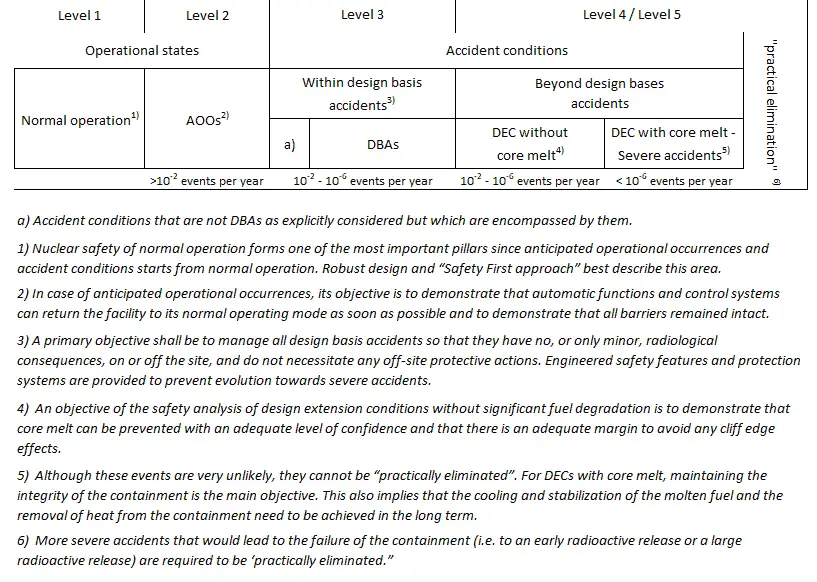The term “practical elimination” appeared for the first time in 1993 in the definition of the general safety objectives for future pressurized water reactors.
The most recent international texts, particularly those issued by WENRA and the IAEA, state that “practical elimination” should be applied to core melt situations likely to lead to early or large releases.
Paragraph 2.13(4) of SSR-2/1 (Rev. 1) states:
“The safety objective in the case of a severe accident is that only protective actions that are limited in terms of lengths of time and areas of application would be necessary and that off-site contamination would be avoided or minimized. Event sequences that would lead to an early radioactive release or a large radioactive release are required to be ‘practically eliminated.”
In this context, an early radioactive release for which off-site protective actions would be necessary but would be unlikely to be fully effective in due time. A ‘large radioactive release’ is a release for which off-site protective actions that are limited in terms of length of time and areas of application would be insufficient for the protection of people and of the environment.
So situations likely to lead to large releases, because of the simultaneous or successive loss of integrity of all the containment barriers or because of the bypass of these barriers (containment bypass situations):
- either lead to define provisions allowing to significantly limit their consequences
- or shall be “practically eliminated”
The event sequences for which a specific demonstration of their ‘practical elimination’ is required should be classified as follows:
- Events that could lead to prompt reactor core damage and consequent early containment failure, such as:
- Failure of a large pressure-retaining component in the reactor coolant system;
- Uncontrolled reactivity accidents or rapid reactivity insertion accidents, in particular, those caused by rapid injection of insufficiently borated water in the reactor core
- Severe accident sequences that could lead to early containment failure, such as:
- High-pressure core melt accidents that could lead to direct containment heating
- Large in-vessel and ex-vessel steam explosions
- An explosion of combustible gases, including hydrogen and carbon monoxide.
- Severe accident sequences that could lead to late containment failure:
- Basement penetration or containment bypass during molten core-concrete interaction (MCCI)
- Long-term loss of containment heat removal
- An explosion of combustible gases, including hydrogen and carbon monoxide
- Severe accidents with containment bypass, such as core melt accidents with containment bypass via the steam generators or the loops connected to the RCS.
- Significant fuel degradation in a storage fuel pool and uncontrolled releases.
“Practical elimination” of such accident situations can be demonstrated by deterministic and/or probabilistic considerations, considering the uncertainties due to the limited knowledge of some physical phenomena. This demonstration can be based on various aspects such as:
- Physical impossibility. For example, a reactor with negative αT is inherently stable to temperature and thermal power changes. This significantly limits the consequences of reactivity initiated accidents.
- Extremely unlikely conditions.
For some external hazards, it may be not practical or even possible to demonstrate that the occurrence of a hazard of such severity that could cause extensive plant damage leading to a large or early radioactive release, and therefore need to be practically eliminated, is below a threshold of frequency such as 10-6/year.
